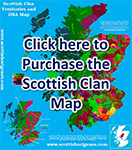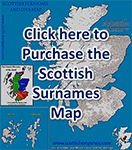You are here
Scottish and Irish DNA Compared
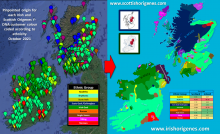 Oct 2021. Scotland and Ireland are close neighbours, and it is no surprise that commercial ancestral Y-DNA testing and the resulting hundreds of Y-DNA Case Studies conducted at Scottish and Irish Origenes have revealed lots of shared ancestry among males with Scottish or Irish origins. However, the belief that the Scots were an Irish tribe that invaded and conquered Scotland does not hold true. If it did, then the Scottish Gaels that dominate the Highlands and much of the Western Isles would have distant Y-DNA matches to males with Irish surnames, they simply don’t (Scottish surnames dominated throughout Scots Gael Y-DNA results).
Oct 2021. Scotland and Ireland are close neighbours, and it is no surprise that commercial ancestral Y-DNA testing and the resulting hundreds of Y-DNA Case Studies conducted at Scottish and Irish Origenes have revealed lots of shared ancestry among males with Scottish or Irish origins. However, the belief that the Scots were an Irish tribe that invaded and conquered Scotland does not hold true. If it did, then the Scottish Gaels that dominate the Highlands and much of the Western Isles would have distant Y-DNA matches to males with Irish surnames, they simply don’t (Scottish surnames dominated throughout Scots Gael Y-DNA results).
What the Y-DNA studies reveal is that the Gaels that dominate the west of Scotland and the northern half of Ireland arrived in Britain as refugees from the Roman Conquest of Gaul (50BC – 100AD) and sought ultimate refuge in either Scotland (Scots Gaels) or Ireland (Irish Gaels) as the Romans advanced throughout Britain.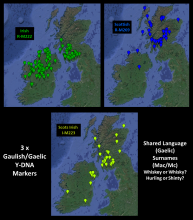 However, there is one group of Gaels, termed the ‘Scots Irish’ (I-M223) that span both countries (Southwest Scotland and Northeast Ireland). The fact that I-M223 accounts for almost 8% of Scottish Origenes Y-DNA Case Studies (compared to 3% of Irish Case Studies) would indicate that the Scots-Irish have a Scottish origin (and that Scottish Gaels carried the I-M223 mutation into Ireland).
However, there is one group of Gaels, termed the ‘Scots Irish’ (I-M223) that span both countries (Southwest Scotland and Northeast Ireland). The fact that I-M223 accounts for almost 8% of Scottish Origenes Y-DNA Case Studies (compared to 3% of Irish Case Studies) would indicate that the Scots-Irish have a Scottish origin (and that Scottish Gaels carried the I-M223 mutation into Ireland).
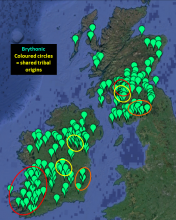 The Gaulish warriors (and their families) had sought refuge among their distant cousins; the Ancient Britons (Brythonic Celts) who dominated Britain and Ireland at that time, and it is the Ancient Britons that still dominate the genetic makeup of both Scotland (44%) and Ireland (50%) plus Wales and much of England. In fact, the Ancient Britons are most notably represented today by the Welsh, no surprise either that surnames that reflect Ancient Briton origin are evident in Scotland and Ireland as Wallace, Walsh, Welsh, and Barton (Dumbarton 'fort of the Britons')!
The Gaulish warriors (and their families) had sought refuge among their distant cousins; the Ancient Britons (Brythonic Celts) who dominated Britain and Ireland at that time, and it is the Ancient Britons that still dominate the genetic makeup of both Scotland (44%) and Ireland (50%) plus Wales and much of England. In fact, the Ancient Britons are most notably represented today by the Welsh, no surprise either that surnames that reflect Ancient Briton origin are evident in Scotland and Ireland as Wallace, Walsh, Welsh, and Barton (Dumbarton 'fort of the Britons')! 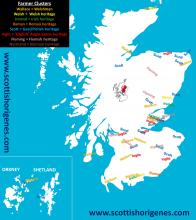 The Ancient Britons of Ireland and Scotland were themselves a mixed group with shared ancestry evident among tribal groups in both countries (requiring a separate blog).
The Ancient Britons of Ireland and Scotland were themselves a mixed group with shared ancestry evident among tribal groups in both countries (requiring a separate blog).
The Ancient Britons that Julius Caesar encountered and described were descended from Celts who emerged from modern Bohemia in the Czech Republic, spread throughout Europe, sailing down the Rhine into Britain and Ireland. The Celts would have encountered a population descended from the (Neolithic) first farmers. 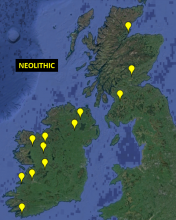 History tells us that first contact between groups of people who have developed separately over hundreds/thousands of years can be disastrous, and the fact that less than 1% of Scots and 4% of Irish males carry a Neolithic Y-DNA marker means that disease (and warfare) decimated the Neolithic population once the Celts arrived. A similar process would have seen the Neolithic’s obliterate the Stone Age inhabitants of Britain and Ireland thousands of years earlier.
History tells us that first contact between groups of people who have developed separately over hundreds/thousands of years can be disastrous, and the fact that less than 1% of Scots and 4% of Irish males carry a Neolithic Y-DNA marker means that disease (and warfare) decimated the Neolithic population once the Celts arrived. A similar process would have seen the Neolithic’s obliterate the Stone Age inhabitants of Britain and Ireland thousands of years earlier.
Unsurprisingly no Roman Y-DNA can be found among males with an Irish Y-DNA signature, when it is found in Ireland it is among the Plantation Lowland Scots and English who poured into Ireland in the early 17th Century. 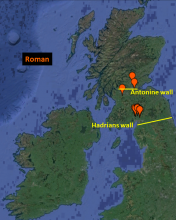 In fact, almost 4% of Scottish Origenes Y-DNA Case Studies have exotic Roman/Mediterranean-associated Haplogroups which lead back to either Dumfriesshire or Central Scotland (close to Hadrians wall and the Antonine wall). The collapse of Roman Britain (4th Century AD) created a vacuum that would be filled by the Scots Gaels who emerged from the Isle of Skye, the Scots Irish in the Southwest (returning from an exile in Ulster/Northeast Ireland?), and Anglo-Saxons who would invade Southeast Scotland (although identifying Anglo-Saxon DNA is a challenge and appears quite rare).
In fact, almost 4% of Scottish Origenes Y-DNA Case Studies have exotic Roman/Mediterranean-associated Haplogroups which lead back to either Dumfriesshire or Central Scotland (close to Hadrians wall and the Antonine wall). The collapse of Roman Britain (4th Century AD) created a vacuum that would be filled by the Scots Gaels who emerged from the Isle of Skye, the Scots Irish in the Southwest (returning from an exile in Ulster/Northeast Ireland?), and Anglo-Saxons who would invade Southeast Scotland (although identifying Anglo-Saxon DNA is a challenge and appears quite rare).
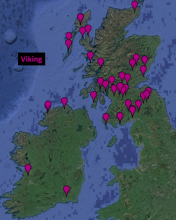 The next major input of paternal Y-DNA into Scotland and Ireland came from the Vikings (800AD), who surprisingly account for 11% of Scottish Y-DNA Case Studies (compared to 2% of Irish). Even more surprising is the fact that Viking Y-DNA is found throughout Scotland but appears centred upon Donegal in Northwest Ireland. While the Viking Age ended in England at the Battle of Hastings in 1066AD, Vikings were still active nearly 40 years later in Scotland. In around 1100AD Magnus Barelegs (King of Norway) was reasserting his control over his Scottish and Irish lands and laying claim to new lands in Southwest Scotland. What Y-DNA Case Studies reveal is that Magnus recruited a mixed army of Norse and Irish Gaels (R-M222) and conquered what would become Galloway (land of the foreign ‘Irish’ Gael). Magnus died in suspicious circumstances in Ireland, and the Irish Gaels and Vikings divided Galloway between them using the River Nith as their boundary. Today, almost 14% of Scottish Origenes Y-DNA Case Studies will reveal an Irish Gael R-M222 marker, a direct results of this Viking Age swan song. Many of the descendants of the Irish Gaels of Galloway would return to Ireland in the 17th Century but as English-speaking Protestant Lowland Scots, whose descendants would, after a couple of generations, depart for the Americas as 'Scots Irish' or 'Ulster Scots.'
The next major input of paternal Y-DNA into Scotland and Ireland came from the Vikings (800AD), who surprisingly account for 11% of Scottish Y-DNA Case Studies (compared to 2% of Irish). Even more surprising is the fact that Viking Y-DNA is found throughout Scotland but appears centred upon Donegal in Northwest Ireland. While the Viking Age ended in England at the Battle of Hastings in 1066AD, Vikings were still active nearly 40 years later in Scotland. In around 1100AD Magnus Barelegs (King of Norway) was reasserting his control over his Scottish and Irish lands and laying claim to new lands in Southwest Scotland. What Y-DNA Case Studies reveal is that Magnus recruited a mixed army of Norse and Irish Gaels (R-M222) and conquered what would become Galloway (land of the foreign ‘Irish’ Gael). Magnus died in suspicious circumstances in Ireland, and the Irish Gaels and Vikings divided Galloway between them using the River Nith as their boundary. Today, almost 14% of Scottish Origenes Y-DNA Case Studies will reveal an Irish Gael R-M222 marker, a direct results of this Viking Age swan song. Many of the descendants of the Irish Gaels of Galloway would return to Ireland in the 17th Century but as English-speaking Protestant Lowland Scots, whose descendants would, after a couple of generations, depart for the Americas as 'Scots Irish' or 'Ulster Scots.'
While the Normans would be invited into Scotland, they would attempt to Conquer Ireland. In both countries nearly 6% of Y-DNA Case Studies show Norman Y-DNA. In Scotland, the most notable Norman ‘Stewarts’ turn out to be the descendants of Bretons (Ancient Britons from Southwest England who colonised Northwest France in around 400AD). So, upon Y-DNA testing the Breton-Stewarts show distant Y-DNA matches to many of the notable Lowland Border clans and families of Southern Scotland (reflecting their shared Ancient Briton origin).
What will your DNA reveal? Contact Scottish Origenes (click here) for a FREE CONSULTATION.


